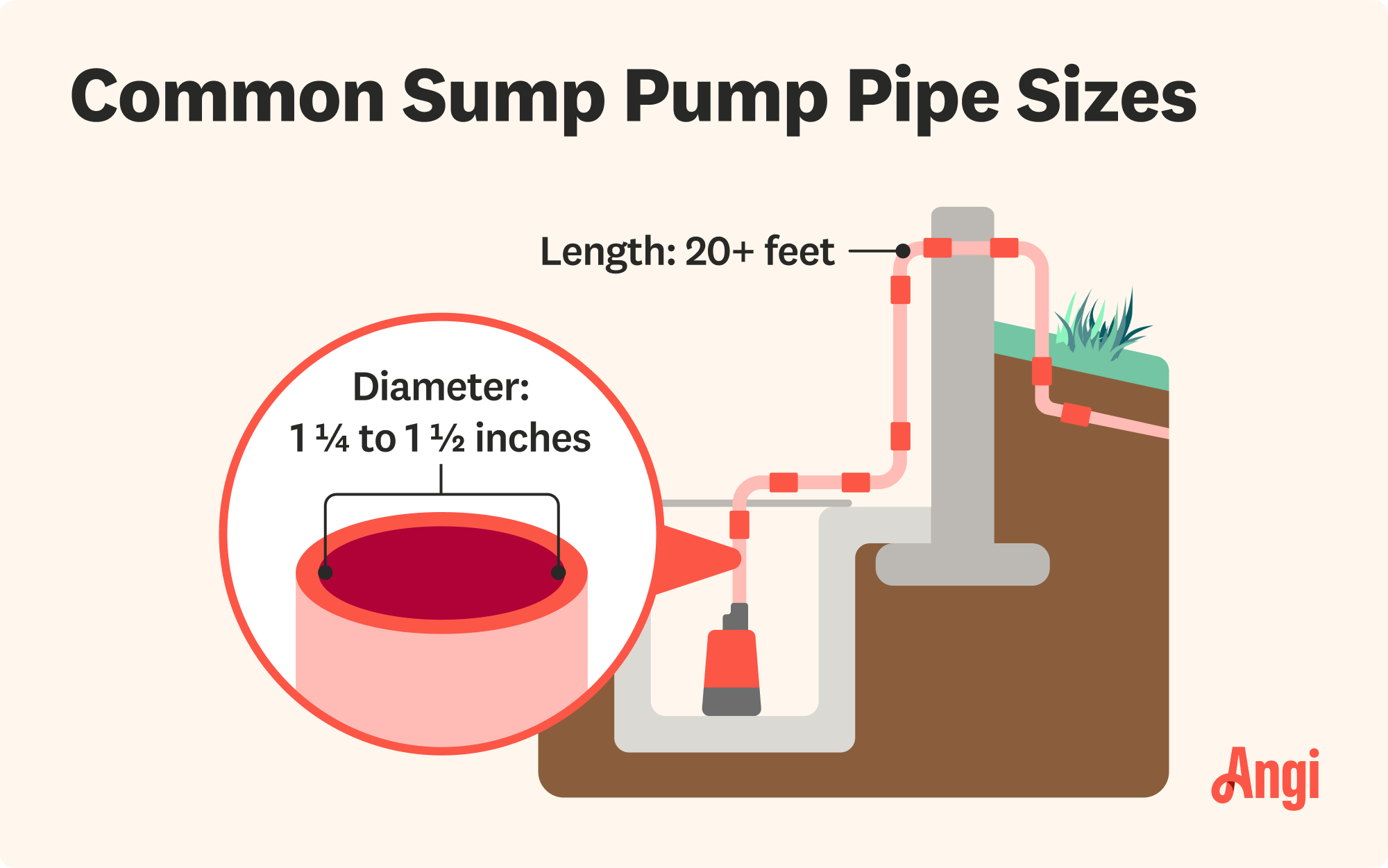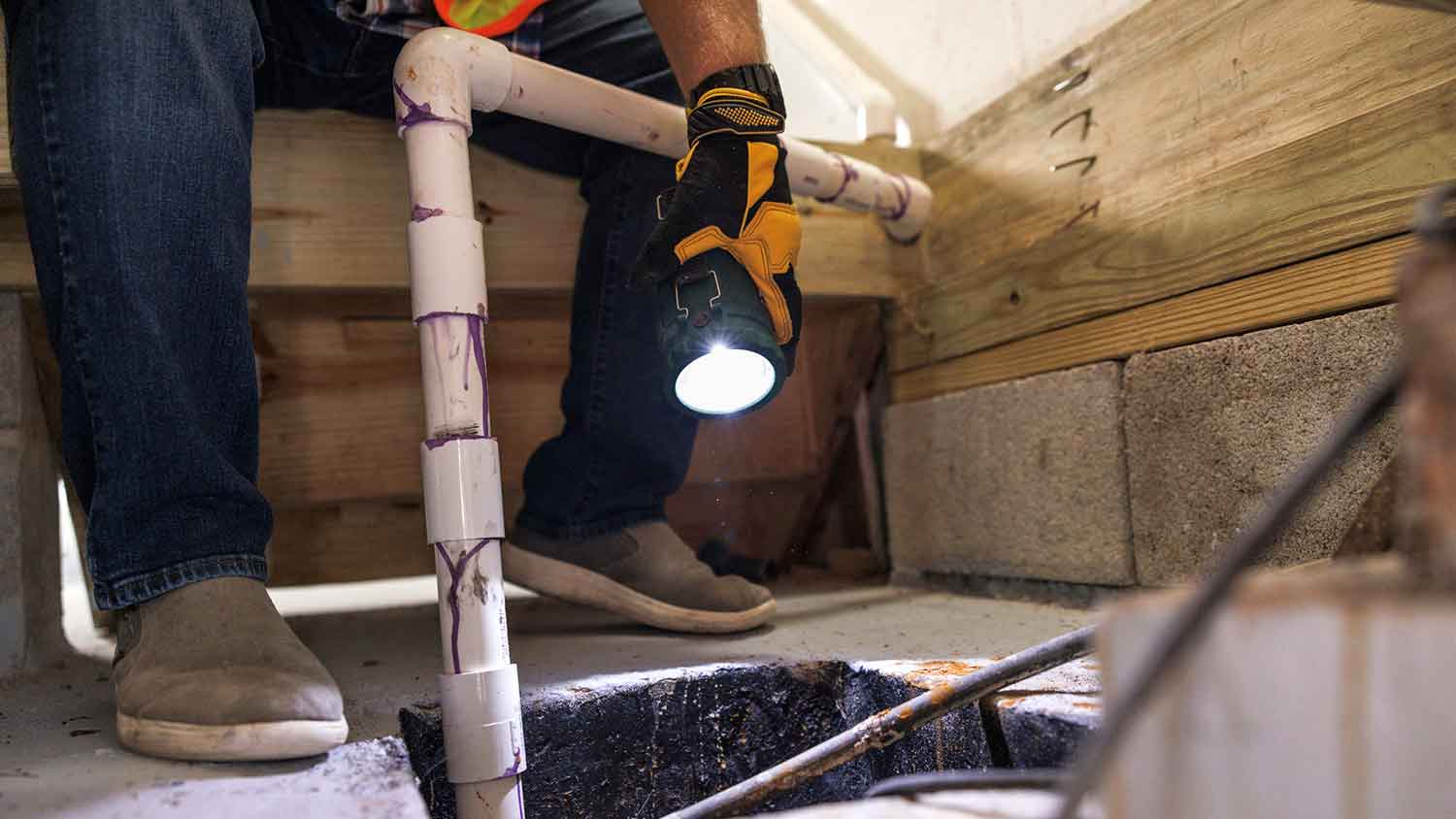Sump Pump Pipe Size: Common Diameters and Lengths for Sump Pump Discharge Lines
The proper pipe size will help your sump pump go with the flow


Also known as discharge lines, sump pump pipes commonly measure 1 1/4 inches to 1 1/2 inches in interior diameter.
Sump pump pipe lengths vary, but they’re at least 20 feet long on average.
Your sump pump’s pipe should discharge water 10 to 20 feet away from your foundation.
If your pipe is the wrong size, your sump pump may wear out faster.
Your sump pump has the tough job of pumping excess water out of your home to prevent flooding and water damage, but the pump doesn’t operate on its own. For the process to run effectively, the sump pump must be connected to the right-sized discharge pipe. So, what size pipe is best for a sump pump? Dive into our ultimate guide to sump pump pipe sizes (and the factors that determine the best pipe size).
What Is the Standard Sump Pump Pipe Size?

When you buy a sump pump, it will have a built-in fitting for a discharge pipe. These openings are between 1 1/4 inches and 1 1/2 inches in interior diameter.
On the other hand, sump pump pipe lengths vary widely. A discharge line’s length will depend on several factors, including:
The sump pump’s location within your home
Your property’s terrain and landscape
Local laws and regulations
With that said, the pipe must be long enough to extend from your sump pump to the outside of your home. It should also discharge water between 10 and 20 feet away from your foundation. Because of this, sump pump pipes often measure at least 20 feet in length.
How to Measure the Right Sump Pump Pipe Size

Since the fitting sizes on sump pumps are fairly consistent, it shouldn’t be too difficult to pick the right pipe diameter. In fact, all you need to do is check the manufacturer’s instructions, which should list the pump’s fitting size. Then, you can buy piping that matches those dimensions.
Calculating pipe length is more complicated. For one, the right length depends on the specifics of your property. On top of that, you also need to understand the pipe’s actual length versus its equivalent length. The equivalent length takes into account the straight length of the pipe itself in addition to the elbows and check valves.
For those reasons, we suggest having a local sump pump installer determine the right pipe length for your home. And unless you have plumbing experience, it’s best to have them install the discharge line, too. If you try to DIY the job and make a mistake, you run the risk of burst pipes, flooding, and water damage, which could cost more to fix than you would’ve spent on professional labor in the first place.
Factors That Influence Sump Pump Pipe Size
When choosing the right size for your discharge line, a plumber or sump pump pro will consider the following factors:
Sump Pump Capacity
A sump pump’s pipe size needs to align with the pump’s capacity. If the pipe’s diameter is too small, it can reduce the flow of water, making the pump less efficient than if it were connected to a larger pipe. It can also force your sump pump to run constantly, potentially reducing its life span.
Sump Pump Installation Location
Pros install sump pumps in the lowest part of your home—often a basement or crawl space. The distance between the installation location and the outdoor discharge point directly affects the required length of your sump pump pipe.
Discharge Line Installation Location
Your pro will need to position a discharge line between 10 and 20 feet away from your home’s foundation. The exact distance you select will influence the length of the pipe.
Also, if you bury your sump pump discharge line underground, the depth you choose will also impact the total pipe length. Deeper installations will require additional pipe.
Local Laws and Regulations
Before picking a discharge location or pipe size, make sure to check your local building codes. Most areas require you to divert your sump pump drainage away from sidewalks and streets. In this case, you’ll need more pipe.
What to Do if You Have the Wrong Size Sump Pump Pipe
Installing the wrong-sized discharge line can lead to several sump pump issues. A pipe that’s too small in diameter can make your pump less efficient and push it to run more than it should.
Selecting the incorrect pipe length can also cause problems. If the line isn’t long enough, it could recirculate the discharged water back into your sump pump (and put unnecessary strain on it). But if the pipe is too long, your pump’s motor will end up working harder to move water across that distance.
If you think that your pipe is the wrong size, call a professional who installs sump pumps. They can check your entire sump pump system to make sure that it’s working properly and discharging to an appropriate location. If not, they’ll recommend what to do next—whether that’s replacing your sump pump, installing new piping, or moving the discharge point.
Frequently Asked Questions
Ideally, your sump pump discharge should run down a natural downhill slope 10 to 20 feet away from your home’s foundation. However, if your property is naturally flat, that might not be an option. Instead, you may be able to discharge it into a neighborhood storm drain or a nearby creek or pond. If that’s not possible, consider burying it underground.
No, you can’t drain your sump pump into your home’s sewer system. In fact, it’s against the law in many places because dumping extra water into a municipal water system can disrupt or overwhelm the treatment process. And for similar reasons, you shouldn’t discharge a sump pump into your septic system, either.
Yes, many people choose to bury their sump pump discharge pipes. When you leave the pipe visible in your yard, you might trip over it or accidentally damage it with your lawn mower. Plus, from an aesthetic perspective, hiding the discharge line underground looks nicer than leaving it out in the open. Before burying a sump pump pipe, review your local building codes to make sure your installation is compliant.
No. Sump pumps have different capacities, which refers to the volume of water that they can remove. They also come in various horsepower ratings, which measure the size of the pump’s motor. For many homes, 1/3 horsepower is enough. But if you live in an area that floods often, you might need a more powerful model.















